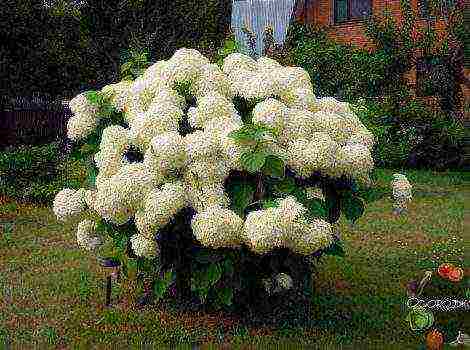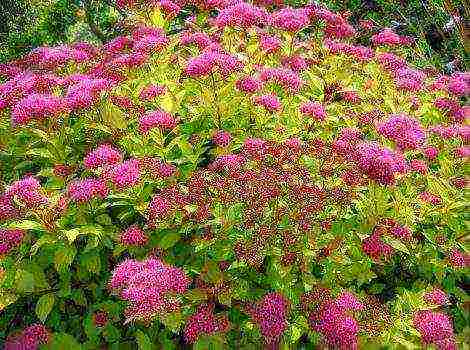Content [show]
Very often, the forest juniper is called the northern cypress. This is not surprising, because it belongs to the cypress family. Its gracefulness, evergreen appearance makes it possible to grow it in summer cottages, creating truly magnificent compositions.
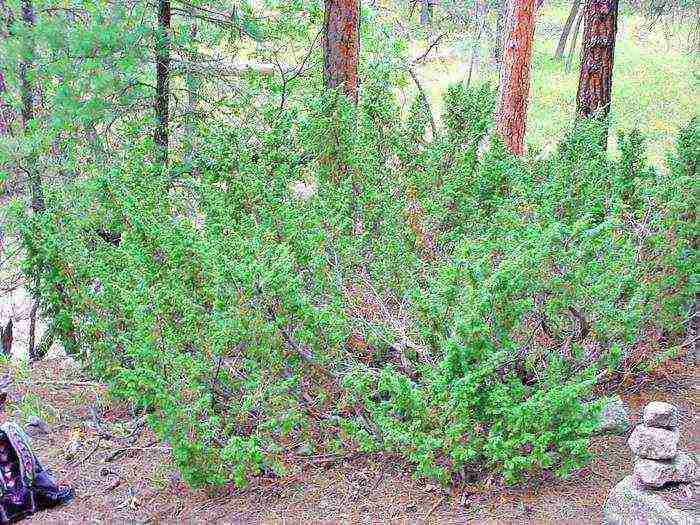
Juniper forest
Varieties
In nature, there are a fairly large number of varieties and species of juniper. Those that are often found in garden plots are unpretentious in care, they tolerate different temperature regimes very well.
Juniper can be divided into two groups:
- Tree-like, tall.
- Shrub.
Popular varieties of the tall tree group:
- Common juniper. It reaches a height of up to 10 meters. The bark is quite dense, the wood has a pronounced aroma. Conical shape. Such a tree grows for a very long time, so it can delight with its greenery up to 200 years. Does not require special preferences, grows well in the shade, easily tolerates frosty weather.
- Chinese juniper (Stricta). A fairly slender tree, cone-shaped, growing high and long. The needles are bluish-green. It is recommended to plant in a sunny area with plenty of free space.
- Virginia juniper. It grows and develops quickly enough. It rises to a height of 30 meters. The crown is wide, the color of the needles is deep green. Easy to care for, does not require special attention, is resistant to diseases.
- Forest juniper. It is considered to be an ordinary cypress from the forest. Most often found at home due to its unpretentiousness. It develops poorly in the shade, prefers a lot of light and sunlight.
- The pyramidal and rocky junipers, as well as the Kibernik and Horstmann junipers, are classified as low-growing plants. They reach up to no more than 3 meters. But they cannot be attributed to shrubs.
Popular varieties of the shrub group:
- Scaly juniper (Meyeri). The shrub stands out for its unusual color of needles, on the tips of which there is a silvery-blue tint. Such a bush planted in the shade will lose its beauty and individuality, it needs the sun.
- Creeping horizontal juniper (Disheveled). The shrub has rather long branches, the needles on which are silvery. In frosty weather, the needles take on a purple hue.
- Cossack juniper. A fairly low plant, it grows about 1 meter. The branches are stretched obliquely, the color of the needles is dark green. The smell is very pronounced. The plant is highly poisonous.
- Juniper Repanda. A dwarf bush, reaching a height of about 40 centimeters, but in width it can grow by 2 meters. He loves light very much, easily tolerates frosts, unpretentious to the ground.
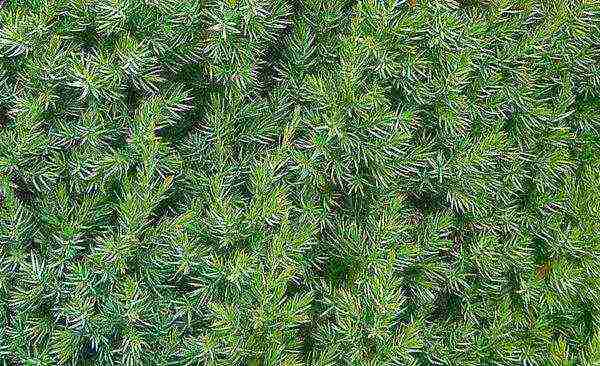
All types of juniper are poisonous to varying degrees, so all work with the plant should be carried out with gloves.
We transplant the juniper correctly
Growing junipers from the forest can be challenging these days. Mostly people refer to literature. More reliable.Information can be obtained from those who have already directly dealt with boarding and leaving.
In order for a plant brought from the forest to take root, certain transplanting rules should be observed:
- Transplanting begins in late winter, or early spring, when there is still snow on the ground.
- Going into the forest for a seedling, you must take a colored ribbon with you. During digging, it is tied to the side where the sun fell. On its site, the seedling is also planted with a ribbon towards the sun.
- When digging up a tree, the earthen lump should be as large as possible, both in depth and in width. If this greatly burdens the transfer of the seedling, the lump can be slightly reduced, but only in depth.
- It is impossible to transfer a seedling without some protection, otherwise the entire earthen lump will crumble. The tree is wrapped in a bag or thick paper.
- There is no need to plant junipers in the scorching sun, they prefer shade or partial shade. You can not place a juniper near an apple tree, this tree is the main carrier of rust.
- You can plant a juniper in several ways:
- In separate pits.
- In the trenches.
- It is not advisable to plant a plant near buildings. In winter, snow falls from the roof, water flows - this can significantly damage the crown of the tree.
- The pit for planting a juniper should be the same size as a clod of earth. The root collar should not be buried.
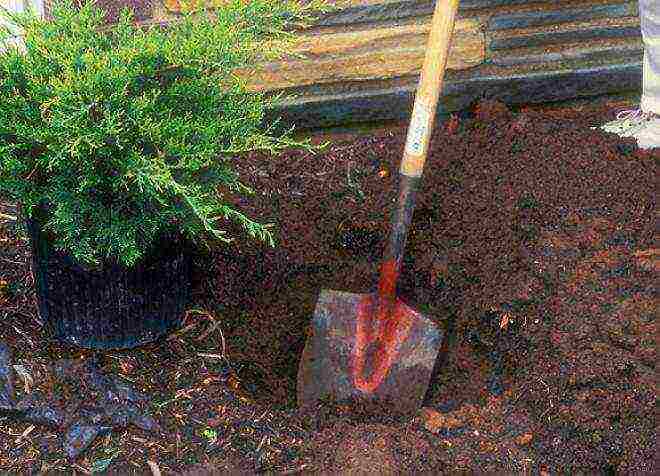
- Junipers are planted in fertile soil, river sand, peat and compost must also be present. When planting, the root system is leveled, and only slightly sprinkled with earth (5-10 centimeters). It is recommended to sprinkle the needles with wet sawdust on top.
- From the soil that remained during planting, a small roller is made along the edge. Pour about 2 buckets of water inside. And one more bucket of water with heteroauxin dissolved in it (one tablet).
Whether the tree will take root in the future depends only on how it will be looked after.
Buying an evergreen tree, propagating it
It is not recommended to buy or replant an adult tree. It will be quite difficult for him to settle down; certain skills and a number of knowledge are also required. You can buy juniper in 2 types:
- In the dug out. Its roots are wrapped in wet sackcloth.
- In a pot.
Basically, the plant is grown in the open field, and only before selling it is settled in containers.
A tree is planted in the spring (April or May) - this is the most optimal period. It is possible in the fall. If the plant was purchased in a container, its root system is formed and protected, so it can be planted at any time.
A tree planted in the shade can lose its spectacular appearance and begin to wither. After planting, you need abundant watering of the root system.
Juniper can be propagated in three ways:
- Cuttings.
- Seeds.
- Layers.
For rooting to happen as quickly as possible, the following conditions should be created:
- Moistened soil.
- Regular spraying.
- Before bud break, the temperature should vary about 16-19 degrees, after blooming - 23-26 degrees.
- No scorching sun, only indirect rays of the sun.
Cuttings of a creeping juniper are rooted obliquely, columnar cuttings - vertically.
With the help of layering, not all plant varieties can be obtained, only creeping and during the growing season.
For planting from seeds, you need to carry out a number of manipulations:
- The seeds are pulled out of the bud and cleaned.
- The cleaned seed is placed in sulfuric acid and left for half an hour.
- Wash thoroughly.
- In the fall, they are planted in a box.
- In winter, they are exposed to the snow.
- In the spring (in May) they are planted.
Cuttings can be obtained at any time of the year, but the optimal period is spring. Initially, the cuttings are placed in a greenhouse, and only at the beginning of June they are planted in open ground, covered with a film.
In order for the grafting to be successful, all actions are carried out in order:
- In April, at a tree that is 10 years old, you need to cut off a one-year-old cutting, the length of which is about 10 centimeters.There should be some old wood on it.
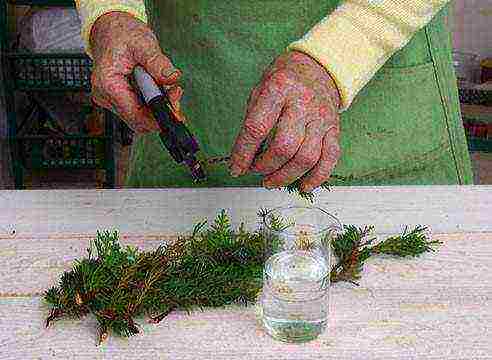
- They are well cleaned of needles by 4 centimeters. The bark is cut off.
- The stalk is placed in a growth-stimulating solution for 24 hours.
- Cuttings are planted in prepared soil and shaded.
- A little more than a month (40 days), the root system will flutter.
- It is better to refuse watering, give preference to spraying.
- In July, the finished seedling can be planted in open ground.
- In winter, they are covered with spruce branches.
- Full rooting lasts about 3 years, only after that the seedling can be transplanted to a permanent place.
All manipulations with circumcision and cleansing are carried out only with a sharp and disinfected object.
It is practically impossible to grow a decorative juniper from a seed, it is better to use cuttings.
We care properly
An evergreen plant does not need much maintenance. You just need to remember simple rules, and your forest beauty will certainly be gorgeous:
- In the spring, top dressing is required.
- The circle near the trunk is kept clean, grass and weeds are removed. Mulch periodically.
- Mulch is placed on black geotextile.
- In winter, it is advisable to tie the crown of the tree with twine so that snowballs do not spoil the appearance.
- Varieties with bluish and yellowish needles are protected from the scorching sun.
- Pruning should be carried out in time, remove all dry and lifeless branches so that new ones go into development.
- Only young seedlings need to be hidden from frost, and then, only the first year.
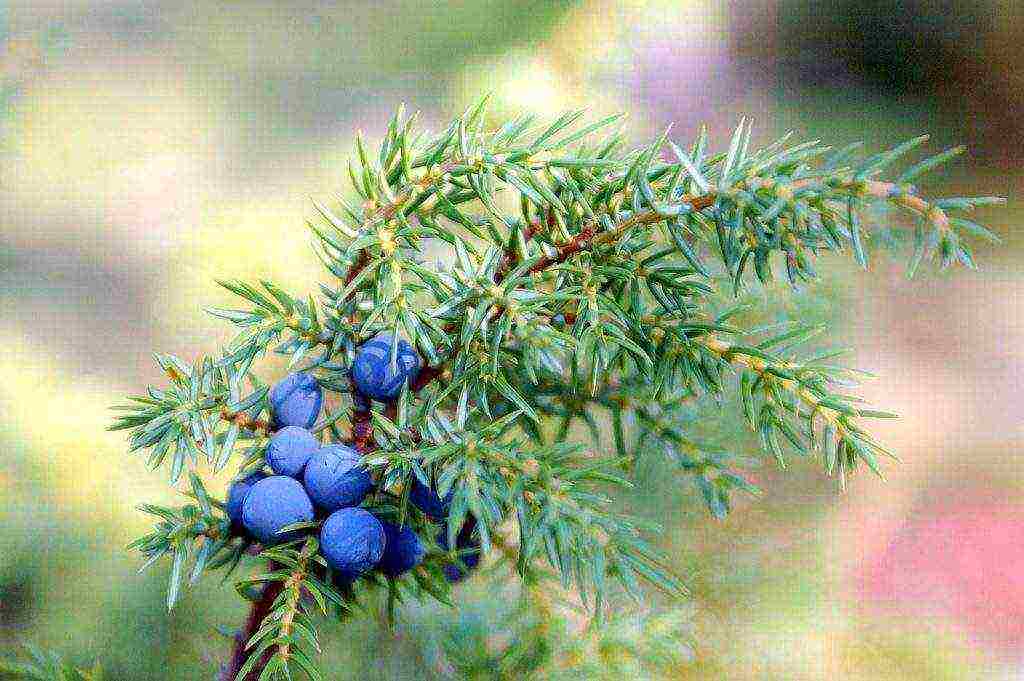
The forest juniper is a fairly tall plant, therefore, during planting, you need to maintain a distance of at least a meter. Drainage is laid at the bottom of the pit.
Young seedlings need watering, adult plants will perfectly outweigh the dry climate. Watering is recommended 3 times a month. On hot days, it is advisable to spray the juniper every 10 days. Do it in the evenings or in the morning.
For one adult tree, on average, 10-30 liters of water is consumed per watering.
It is very easy to decorate courtyards with the help of forest juniper. It is often used in landscaping.
Pests and diseases of an evergreen plant
Forest juniper can overtake such diseases and pests:
- Rust. When it appears, the plant begins to turn yellow. For treatment, use a solution of Artsedir (50 grams per 10 liters of water).
- Schütte.
- The mold is gray.
- Juniper mining moth. For treatment, Decis is used (2.5 grams per 10 liters of water).
- Spider mite. The drug Karate copes well with the problem (50 grams per 10 liters of water).
- Juniper scabbard. Karbofos will help (70 grams per 10 liters of water).
- Aphid. Spray with Fitoverm (2 grams per liter of water).
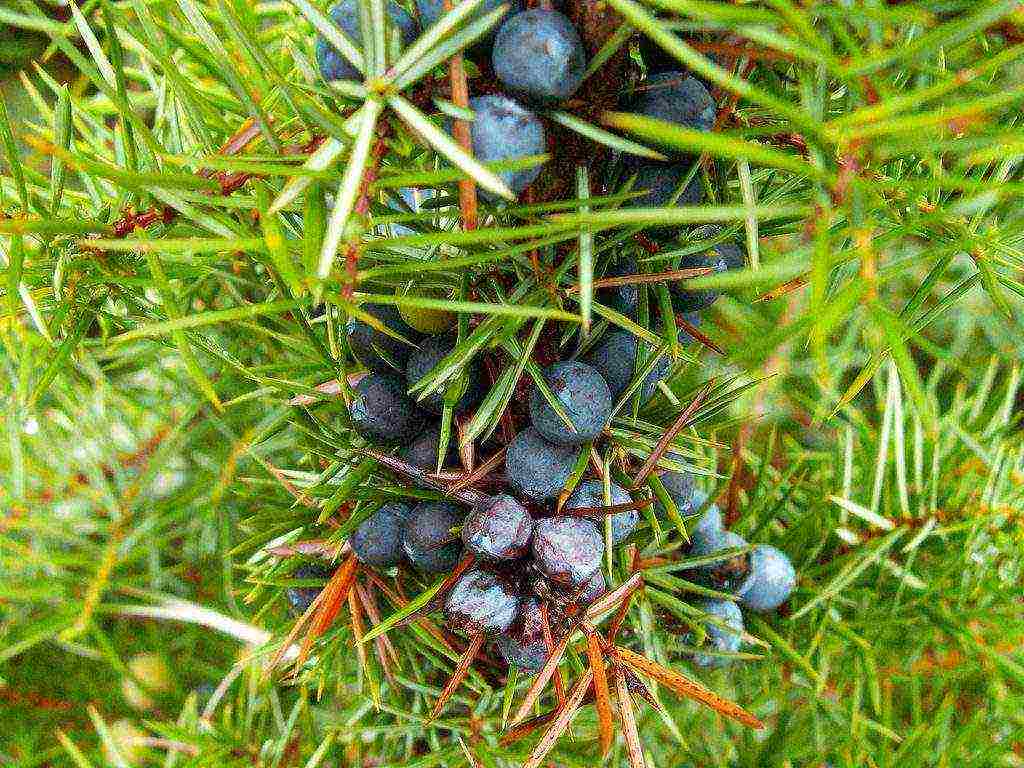
All these problems can be avoided if the plant is properly cared for, all tools are disinfected, and only high-quality soil is selected. If you find the problem early, then curing the tree will be quite simple and quick.
Healing properties
Juniper is a very useful tree, especially woodland. Where it grows there is always fresh and clean air. Walking in places with such a plant, the head stops hurting, the mood rises, depression goes away, pacification sets in, sleep is normalized. It is not for nothing that cypresses are planted in rehabilitation clinics, parks, sanatoriums and rest homes.
Since ancient times, various infusions have been made from cones and needles of plants. They helped fight diseases of the kidneys and genitourinary system. Decoctions are used to relieve skin diseases, eczema.
Essential juniper oil is gaining more and more popularity. It is able to cleanse the body of toxins and toxins. It also heals:
- Various skin diseases.
- Bronchitis.
- Osteochondrosis.
- Pneumonia.
- Influenza and colds.
- Viral infections.
It is useful to add a few drops to the bath. Thus, the body gets relaxation and the immune system is strengthened.

Previously, it was very common to find a juniper broom in a bath. In the old days, people used to go to the bathhouse to improve their health.
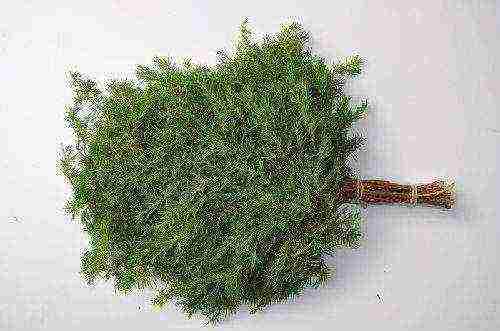
Moreover, the juniper is also used for magical purposes. There is a belief that brooms from this plant protect against damage, evil eye, slander and disease. Small brooms are hung around the house, and even in the barn with animals. Various amulets and charms are made from juniper.
A tree planted near the house can scare off ill-wishers and thieves.
When using the plant, you need to be extremely careful, since many varieties are poisonous. For example, Cossack juniper. It is easy to recognize, it does not grow upward, but spreads wide, its fruit has 2 seeds. The common juniper fruit has 3 seeds.
In any case, before using this plant, you need to consult with a specialist. Self-activity can lead to serious health problems.
Juniper can be used as a seasoning for some dishes, for example, in the preparation of smoked meats.
Gardening experience
A lot of necessary information on growing juniper can be learned precisely from the experience of gardeners. They recommend paying close attention to grooming in the first six months. Water the tree in time, fertilize, remove weeds around it.
If you want to get a not tall plant, you need to prune in the spring. Do it before new needles grow back.
Unfortunately, it is not so cheap to buy young seedlings. Therefore, it is more often practiced to transplant cypress into the garden from the forest. If done correctly, the process will be successful. The plant will not only delight with its beauty, but also bring undoubted benefits (therapeutic, preventive and sanitary and hygienic).
|
Junipers from the forest In the spring I was given three juniper bushes found in the forest. I prepared the pits, poured there garden soil in half with sand, a little manure and planted. I watered often at first, then less often. But they dried up after a couple of months. In September, I found another juniper branch in the forest. I dug it out with a lump and planted it. Now he is again not as green and lively as he was before, although not yellow.
|
|
1 She transplanted junipers from the forest - out of 6 rooted 4 - transferred them to her garden only because they were cutting down in that place. Taking only with a large clod of earth and planting right there and at the same time fixing the cardinal directions as it grew in the forest and planting it in the same way in the spring is advice for the future. And now - wait and plant a new one in the spring, but if it is so difficult to find a juniper in your nature, then you can leave them to live where they live, and send your desire to see a plant in your garden to buy a juniper of the shape you need. (When I see sellers with a bunch of forest junipers with bare roots that are 100% doomed, I want to strangle the freaks - there are so few junipers in the forests and they grow for so long).
|
|
2 In the market, I also saw with open roots. I didn’t take it, although they didn’t ask for it dearly. And those that I have - just from the felling, are going to build something there. In general, now it is not a forest. It's just that our village is right in the forest and is slowly spreading.
|
|
3 Conifers generally do not tolerate exposure (and even more overdrying) of roots - they are mycorrhizal plants. Manure - not at all !!
|
|
4 I want to share my observations on growing juniper from the forest in the garden. They brought him from nature, not very small, and planted him in front of the house in the front garden - and this is the north side, and there is almost always a shadow.Nothing was added to the soil (we have very damp loam + peat), and no one guessed to orient it to the cardinal points either. As a result, the juniper did not live, but suffered, it looked monstrous: all yellow and shabby. I also reprimanded my parents: what kind of nonsense they brought from the forest, please, don't wear anything else from there. After 3 or 4 years, making sure that the look of the plant would not get better, they decided to take it out after all - they moved it literally 10 meters, though this time they placed it on the same cardinal points, but nothing was added to the soil again, but the most decisive moment was the fact that the juniper was in the sun. A season later, I could not believe that this is the same plant that just recently jarred my aesthetic feelings with its appearance! Green, fluffy, spreading, with my height - right at least to the exhibition !!! (ugh * 3 so as not to jinx it). In the forest, they are not as beautiful as they were behind the fence. Now I'm thinking about the topic: maybe I should return it back to the garden? Create some kind of decorative group with his participation ... In general, it seems to me that you cannot guess the landing site. When you go around the area with the dowsing frame, in some places it just jumps (maybe there is groundwater or something else) - this is observed on the heel where the juniper grew earlier. And if you move a few steps to the side, everything is favorable there. As for forest junipers, one experienced gardener told me that adult plants practically do not take root, and only small specimens should be taken from nature - these grow without problems, however, it takes a long time ... |
|
5 A little more than 10 years ago, my employee brought from Ignalina from the forest 2 junipers 0.5 m each - not small, and there was no talk of a coma of earth and how they grew, he also did not remember. I described to him how slowly they will grow and that more than 1.5 m in the forest is generally a rarity. He planted them in front of the house. One was killed immediately, and the second was 2 meters tall.
|
|
6 I also planted forest trees several times. I totally agree about the cardinal points and the spring planting. In the fall I planted two, and both died. And all the spring ones survived. True, you really can't guess the location. One of me seemed to sit well and bend over. Transplanted into the shade, in the far corner - he lives and is well, green, fluffy. I took care of him with epin and root. But in the shadows! Although I must say that in the area of my site there are a lot of them in the forests, they grow in the lower tier, and the forests are coniferous: pines like Shishkin's, and, frankly, ate, not small. Therefore, junipers do not receive a lot of light. |
|
7 Angelina
|
|
8 I recommend driving a stake to the juniper planted in autumn and tying it tightly so that it does not blow with the wind and wrap it with burlap on top for the winter. If it nevertheless begins to turn yellow in the spring, do not rush to throw it away. If at least one green shoot remains by the beginning of June, then there is a chance of survival. True, the forms are funny. In this way, my friends grow a one and a half meter "broom" on a meter "handle". From my experience, it follows that junipers should be replanted only in spring, and the sooner the better. And to cook the pit in the fall. I have a positive experience of replanting a bush on an area 1.2m high and about 0.7m wide. They were transplanted in early spring with a long clod of earth that was still partially frozen (the earth was just beginning to thaw and there was solid mud around). When transplanting, I pruned the bush. After the transplant, he did not even turn yellow anywhere and immediately began to grow. The early spring planting of small forest junipers was always successful. I did not bother with the cardinal points, but I always drove a stake near each one and tied it tightly to this stake so that the plant would not be blown by the wind. tether In our forest, they grow under the trees, but they are all very stunted. On my site, everyone is in the light and feels good. The shape and size of natural species can be different. My first savage has been growing on a plot in the sun for 15 years already - a cone-shaped shape without a haircut, a height of 4-4.5 m, although I have never met above 3 m (Karelia) in nature.
|
|
9 nach0 |
|
10 Realizing the idea of fixing a hedge of junipers, I planted a package of juniper fruits from a pharmacy two years ago before winter. The result - in two years almost everything has grown - 50% in the first spring, the rest this spring. The seedlings were in the fall (August) were planted in containers, overwintered. Moreover, from 45 pieces. only one died. Over the summer, they grew by an average of 10 cm. They were buried in partial shade. The seedlings, which appeared this spring, were again planted in containers, buried in the ground and covered with coniferous litter from under forest junipers. The experiment continues.
|
|
11 I have 8 pieces of wild junipers from the forest. Survival rate is 100% when planted from April 25 to May 25. Do not forget to trim the crown symmetrically to the loss of roots. Water with root formation stimulants, plus foliar treatments with them in a lighter concentration. Just spraying the crown during the engraftment period ... I collect berries on my site and make my own genie :-)
|
|
12 Can you share the recipe? :)
|
|
13 Galya, and "mycorrhizal" - how is it?
|
|
14 Only for Anna
|
|
15 Oddly enough, my experience of replanting junipers from the forest is positive. But, unlike the opinion of the majority, a specialist from the GBS told me that this should be done when, after frost, the soil layer is 5-7 cm thick.dug up and placed in a pre-prepared hole. By the way. spring planting from frozen soil is very similar to this recipe. The shape depends on the gender - men are thin and tall, ladies are wide and thick.
|
|
16 Ksyu, can I just give a link to the biologist's notes, I still can't explain it better: And there are still many interesting points regarding conifers 🙂
|
|
17 Transplanting conifers from nature is similar to playing roulette (with slightly better chances, of course. The main thing is that the younger, the more chances. Orientation to the cardinal points can be essential only for adult specimens. Much more important is the size and non-dryness of a clod of earth and good illumination. survival rate and from drying out in spring, frequent and abundant spraying on the crown from a garden sprayer, in spring, from the moment the soil begins to thaw, this is much more important than watering. Any soil near Moscow is suitable both in composition and in acidity (except for extreme extremes). On heavy loams (this is my case) they take root longer, but 2-3 years after planting they begin to develop luxuriously, although it is better to dig up the clay with sand and add coniferous sawdust. It is better to mulch with fine granite gravel or coniferous sawdust, which almost cannot be used anywhere else. For the winter, you need to tie it to maintain the shape of the crown. Best of all with an electric wire in plastic insulation. 6 years ago I planted 6 young animals of 25-30cm from the nearest forest. 3 are alive, the rest died in the first year. All men. They grow in the sun 40cm from the drainage ditch covered with rubble (dry land). Do not burn (spraying). Height 180cm with annual haircut, of which this year's growth is 30-40cm. Columnar shape. The crown is very dense, 50-60 cm in diameter, inside the crown, i.e. in the shade, the needles are bluish-blue. By the way, one of the bushes has a very beautiful weeping shape in the form of an inverted trapezoid, which appeared in the 3rd year. So there is a reason to experiment.
|
|
18 I transplanted two bushes 30cm and 70cm at the end of May, both took root, although it was hot. I dug it out with a large lump, after planting, I immediately watered it, sprinkled it on the crown, stuck in a couple of stakes, put on pe bags and did not take it off until they took root, sprayed it daily. Now they are growing beautifully.
|
|
19 Junipers take root well at a young age. In the spring, when transplanting, it is necessary to maintain lighting conditions, a north-south orientation, and, of course, a large root ball - success is guaranteed.
|
|
20 A neighbor was in the suburbs in the forest and dug up a couple of pieces of junipers. She gave one to me, and I was not there, and she dug it in. I overwintered. Then I transplanted him to the fence. There is a shadow, but we can. alive and green. Let's see what will happen next.
|
|
21 I transplanted two junipers from the forest, both took root remarkably, after a few years I transplanted one with a large clod of earth - it took root. I didn't water it with any stimulants, just water and that's it.
|
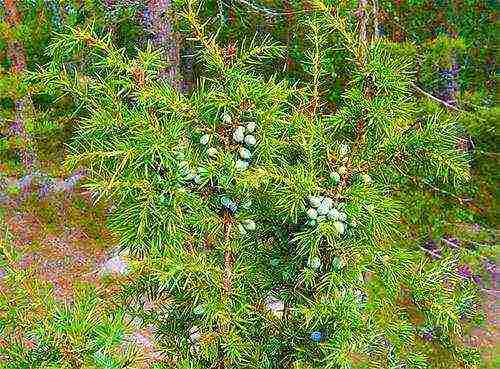
An evergreen juniper from the cypress family can increasingly be found as a decoration for summer cottages in our area. I notice this during my trips to the settlements of our country. Beautiful and unpretentious, this shrub allows you to create various compositions, embodying the creative ideas of the author.
However, there is little reliable information on the correct selection and planting of junipers. Many materials are written by people who themselves did not have practical experience of growing this plant on their site, and therefore their knowledge exists in isolation from reality.
You can often hear or read the recommendation not to grow it at all.
a plant, due to the fact that there is not enough space for it on the site, and it
is poisonous.
Pros: in fact, the juniper takes up a little space, is easy to care for, calmly tolerates the shade. Concerns about the high toxicity of the plant can be attributed to the Cossack juniper, but not to the ordinary one.
Some guidelines allow for growing junipers from cuttings purchased from vendors. Although this is a rather long process and it is not always possible
guarantee a positive outcome. While there is a way out - it is proposed
buy ready-made seedlings in pots.
True, first these seedlings need to be found, they are not always available. In addition, juniper seedlings are quite expensive. As a way out, those who want to start this beautiful plant on the site, we can advise you to simply transplant the juniper from the forest.
Rules for transplanting juniper from the forest
Transplant timing
You can often read that the juniper should be replanted in the fall, after the completion of all work on the site.
However, practice shows that it may simply not have time to settle down before winter and will be painted in the color of rust. To avoid problems, it is better to immediately prepare for transplanting in early spring, when the ground has just begun to thaw.
Extracting a seedling
And the first question that you will face is where to dig up the juniper? It may well be that in your area it does not grow in forests ... Study the relevant literature.
If you are lucky and you have found a wild juniper, then after the seedling is selected, you must definitely mark the side on which the sunlight falls in any convenient way. This is done in order to properly plant it in the garden relative to the sun.
When digging up a future seedling, you need to work with a shovel within the boundaries of the branches along the perimeter. You need to deepen the shovel to the depth of the bayonet and dig it out together with the largest lump of earth and lobular roots.
If the lump cannot be lifted, then it should be relieved by depth. As soon as the bush is removed, it must be placed on plastic wrap and, wrapping a lump, tie the edges with twine to the trunk.
Choosing a landing site
When choosing a place to plant a juniper, it should be borne in mind that it is a carrier of a common disease of apple trees - rust. Therefore, it is worth planting northern cypress as far away from them as possible.
The selected area should be located in the shade or partial shade, away from buildings, so that in winter the snow falling from the roofs does not damage its crown.
You need to plant a seedling either in a hole on the lawn, or in trenches, when
alley placement.
Preparing a pit or trench
When planting, as usual, the root collar should be at ground level. For this, the planting hole or trench must be equal in depth to the thickness of the lump to be planted.
Before planting, it must be filled with a mixture of garden soil, river sand, compost or peat. The roots of the seedling must be well spread over the surface, covered with soil by five to ten centimeters and sprinkled on top with mulch from humus, coniferous litter or coniferous wet sawdust.
The rest of the soil that remained after digging up the landing site must be used to create an earthen roller along the edge. Then you need to pour two buckets of water into the bowl of the trunk circle and pour a bucket with a solution of one tablet of heteroauxin dissolved in water around the perimeter of the bowl.
Follow-up care
The first six months after transplanting the shrub, it needs to be watered every week with two buckets of water and the weed area of the trunk circle should be removed. If the tree is poorly shaded on hot days, it is advisable to spray the crown and cover with any loose cloth.
Juniper should be trimmed in May, before fresh needles can grow. The plant's near-stem bowl must be expanded annually.
To do this, a small ditch is dug around the crown on the bayonet of a shovel, into which leaves, needles and weeds are laid, everything is sprinkled with lime on top and a new roller of the barrel bowl is created annually over this place.
These simple actions will allow the summer resident to acquire a beautiful evergreen shrub, which will become a real decoration of the site.
In addition to decorative properties, juniper also has medicinal properties. Its cones, which are formed after pollination of female cones, contain essential oils used to treat wounds, burns, and frostbite. The branches and needles of the plant have a disinfecting effect, helps to destroy putrefactive fungi, bacteria, influenza viruses and tubercle bacilli on the site.
Read also
How to grow a juniper (planting and care rules) -
Information about the cultivation of Cossack juniper, as well as an overview of its best varieties -
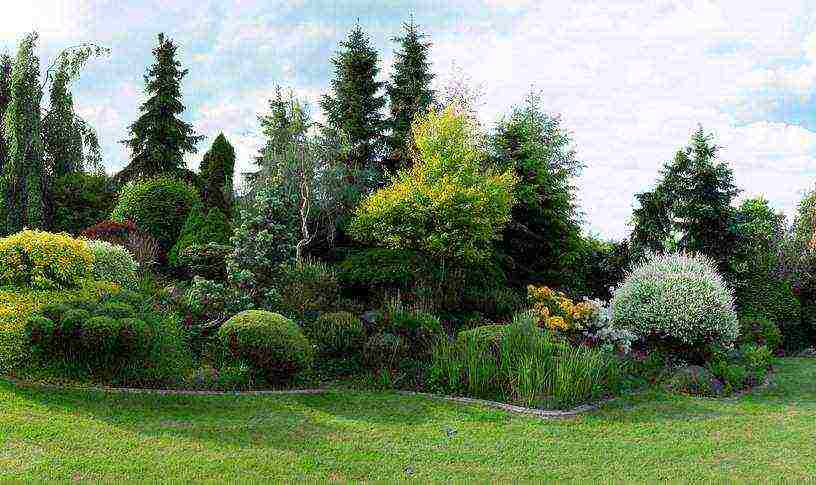
Shrubs and conifers, thanks to their richness of forms and magnificent appearance, are a valuable element of landscape design. They enliven the landscape, create decorative contrast or backdrop for other plants, and protect the site from cold and environmental pollution. Conifers are beautiful at any time of the year, but most appreciate them in early spring, winter and late autumn, when the garden loses a lot of its aura along with the falling leaves. How to grow junipers, planting and care in the open field, varietal differences - these and other issues are discussed in this article.
Conifers in the garden
Conifers and shrubs are planted in the spring when the growing season begins or in the fall when it ends. They are bought with a whole root system and a clod of earth, watered and planted no deeper than they grew in the nursery. When choosing conifers, special attention should be paid not only to the appearance of their aboveground part, but also to the quality of the roots. The soil for conifers must have a certain structure, moisture, airiness and acidity. The parameters must correspond to the requirements of individual species and varieties. It is also worth knowing that not all shrubs and conifers can be transplanted. Below you can read about how to arrange a garden with such plants, how not to overdo it with their number, and how to cultivate different species.

Conifers are planted individually or in groups. They look beautiful in plantings of species and varieties with different textures and shapes. These rocks look decorative against the background of well-groomed grass and near the water. They can also be the original support for colorful vines such as honeysuckle and clematis. Rhododendrons, azaleas, forsythia, bulbous plants look great against their background.
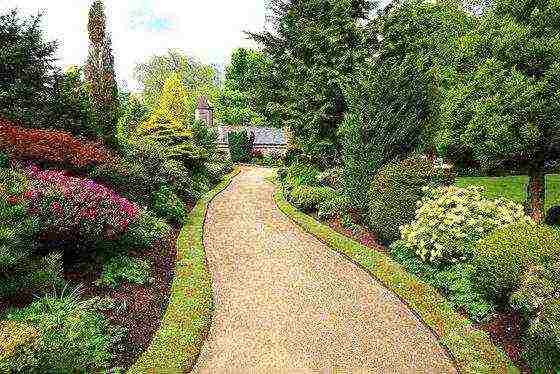
Potted seedlings are planted according to the gardener's preference. Since some shrubs and conifers produce a certain humid microclimate, it is worth placing them next to a gazebo or veranda.
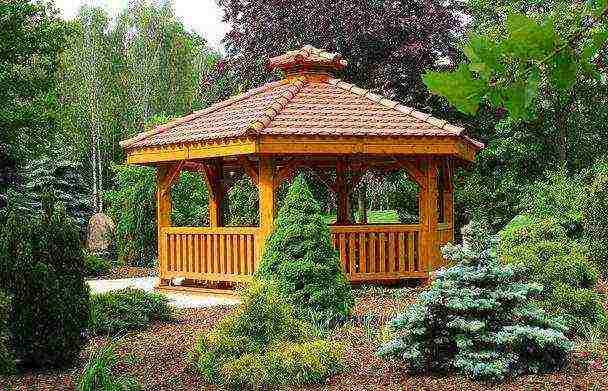
Small conifers, commonly known as dwarfs, are very popular. Shrubs and dwarf pines usually have shallow root systems and therefore require mulching to protect against overheating, root freezing and excess moisture evaporation. Dwarf plants are often planted in stone gardens or hedges. In winter, they are covered with soft snow, creating a fabulous atmosphere.
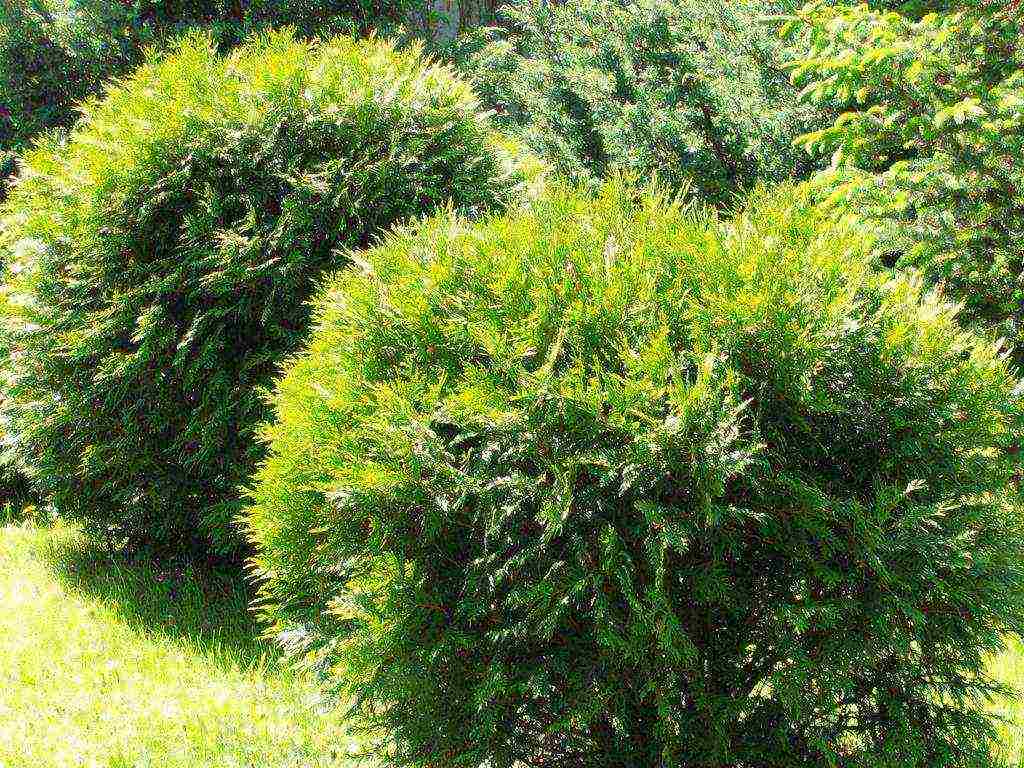
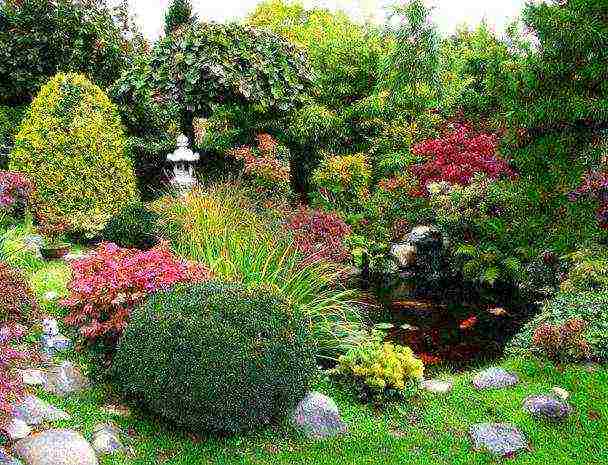
Tall conifers wrapped in snow also look phenomenal. Some shrubs and trees, such as junipers, pine and fir, have medicinal properties.

Juniper - varieties, photo
Junipers are conifers with a low degree of overgrowth. In decorative plantings, they are found in countless varieties:
Juniper is a typical inhabitant of marginal soils. Most often these are bushes, less often conifers with a blue-green color. Their young needles can be prickly; with age, the needles become more and more scaly.Ripe juniper berries have a pleasant dark blue color and are very popular with birds.

The plant is resistant to low temperatures and drought. Grows well in poor soils, such as rocky.
Immersion in soft greens - creeping juniper
Creeping varieties usually perform the role of ground cover plants, laying well on the ground. The bushes quickly form a dense green carpet. They are hardy and require little maintenance. In nature, creeping species grow in places with unfavorable conditions. This is especially true in areas where strong winds blow, the snow period is long, and the land is barren or too wet.
The creeping juniper comes from the northern regions of North America, where it is found on the rocky sandy shores of seas and lakes. Grows in any poor soil, preferably open in a very sunny location. In autumn, the needles take on a beautiful purple color.
Photo. Creeping varieties:
Common juniper - description
This is a shrub, less often a tree from the cypress family, growing up to fifteen meters in height. The crown is usually flat, narrow or wide, oval, maybe spherical. There are also shrub, cone-shaped or spindle-shaped forms.
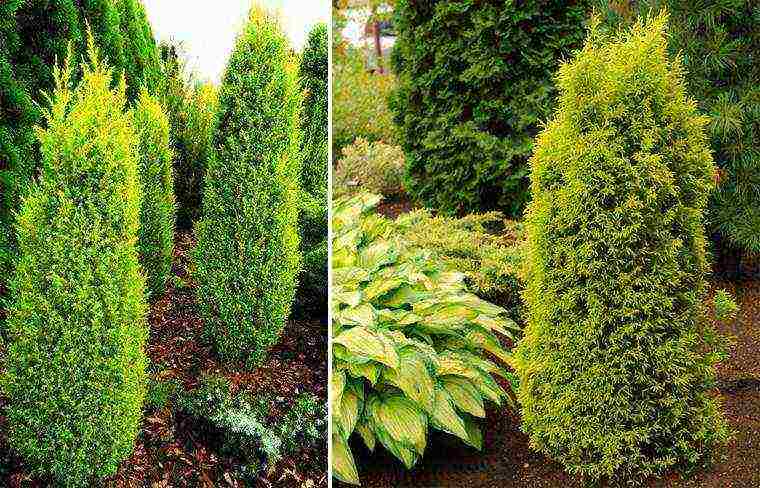
The crown is dense, compact, sometimes light and transparent. Because of this variety, it is called variable. Young specimens have dark gray and longitudinally scratched bark, while older specimens have small scales. The plant is frost-hardy; heavy, wet snow brings the greatest damage in winter. It develops poorly in conditions of polluted air.
It grows slowly, but it can live for over a hundred years. It is found almost throughout Europe, Asia, North America and North Africa. Distributed mainly in the lowlands and in the lower mountainous regions. In the wild, it is distributed by seeds that germinate only after freezing.
In nature, it grows in humid, acidic, poor, arid and dry places - on limestone slopes, sand dunes. Feels good in the company of blueberries, silver birch and pine. Requires an abundance of sunlight for good growth. In the vicinity of the juniper, pine seedlings are well accepted, they grow much faster than outside its range. In young forests near junipers, mushrooms grow faster. This is because fallen juniper needles, which decompose faster than other trees, produce non-acidic fertile humus.
The common juniper is a dioecious tree, which means that there are both male and female flowers in one specimen. Male flowers are yellow and spherical, while female flowers are light green.
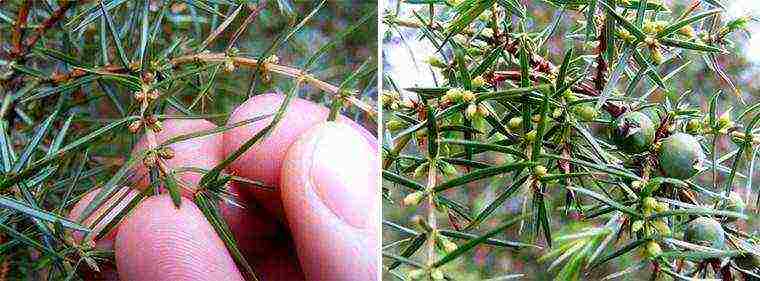
Flowers appear in June, they are hardly noticeable and are laid in the corners of the needles. The spherical cones of common juniper ripen at the end of September, acquiring a dark color with a bluish flower. You can also find green juniper berries on shrubs that have developed in the spring and will ripen the next year.
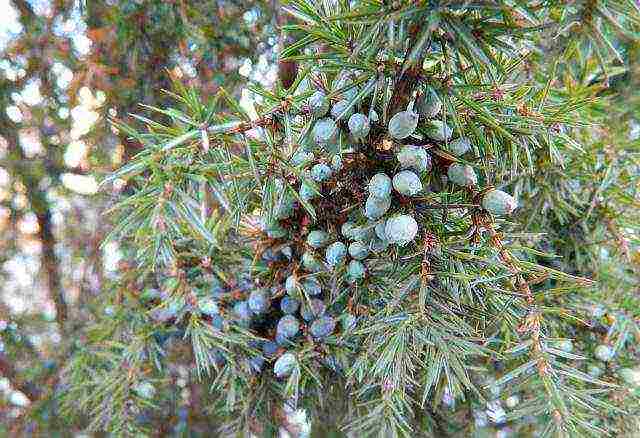
Planting and leaving
Common juniper is an undemanding evergreen plant. It is suitable for every garden, especially recommended for swamps and coniferous compositions.
The plant is easy to plant and does not require any special care. Seedlings purchased in a container can be planted during the period when the soil does not freeze (almost all the time from March to November).
However, if we cannot organize regular watering (very important at first for newly planted plants), it is better to choose early spring or (even better) autumn, when the soil is the wettest and evaporation is not so intense.
Landing site preparation
- Make sure the soil:
- permeable, sandy, poor, fertile or sandy loam;
- moderately wet or dry;
- slightly acidic, acidic or neutral.
- Make sure the position is:
- sunny or partially in the shade.
Soil preparation
- Weed removal.We carefully remove weeds so that they do not compete with the newly planted plant for water, light and nutrients. By using additional agrofibre or mulching, we limit the growth of weeds in the future. Inside the site, weeds are removed manually or chemically with a herbicide.
Important: When using a herbicide, read the waiting period information so as not to damage new plants.
- We dig a hole with a diameter of 30 cm and a depth of 40 cm. The hole should be large enough to place the plant in it and sprinkle the root ball around with the earth. It is easier to use the technique than a regular shovel.
- Pour fertile soil at the bottom of the hole to a height of 5-10 cm. This will help improve the activity of the roots, it will be easier for the plant to root deeper in the soil.
You can use a pitchfork and a shovel to loosen the soil at the bottom to a depth of up to half the length of the shovel.
Plant preparation
- Soak the root ball for 10-20 minutes. Keep the entire pot in a bucket of water until the root ball is well saturated.
- If, after removing the plant from the container, it turns out that the roots are tightly knocked down and twisted, the root part should be cut in several places using a pruner or a sharp knife. This loosens the roots and makes it easier for the plant to take root.
- Cut back the shoots by 1/3, thickening the crown.
- Remove dry leaves and damaged shoots. This will give a more pleasant appearance to the plant, relieve it of potential diseases.
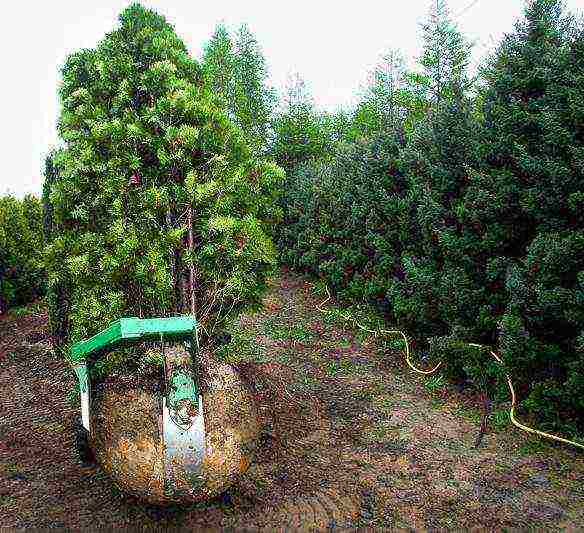
Planting a plant
- Place the root ball in a 15 liter pit of fresh soil. Pour the upper fertile layer of earth into the lower part of the pit, and then insert the root ball. In the case of using a plant from a container, it is planted to the same depth as in the container (perhaps 3-5 cm below the surface of the earth). This task will be facilitated by placing a stick on the edge of the hole, which will determine the appropriate depth for the root ball.
Important! Planting depth is extremely important: you cannot plant the plant too deep or too shallow. The root collar - a piece of a plant between the roots and the aboveground part - should be located at ground level.
- Backfill with soil halfway up. New roots will grow and need to be provided with a nutritious substrate. The rest of the hole can be filled with regular soil dug from the garden.
- Compaction lightly and sprinkle with soil if necessary.
- It is good to form a cavity around the plant, a wide rim that will retain water and facilitate its flow to the roots. Form a bowl of earth around the hole so that water reaches the roots while watering and does not run away from the sides.
- Watering. The plant should be watered abundantly (especially if planting occurs mid-season). After watering, the soil can still settle, revealing the roots. In this case, cover with earth.
Watering
Do not forget about watering in the first years of cultivation (first 2 years).
There is a rule of watering: it is better to water once and well than often and sparingly.
Frequent and sparse watering forces the root system to develop at the surface because the roots find moisture in the upper parts of the soil.
On the contrary, if the plants are watered infrequently, but abundantly, the roots are located deeper. Effect: In subsequent years, the plants do not need to be watered, except during periods of drought.
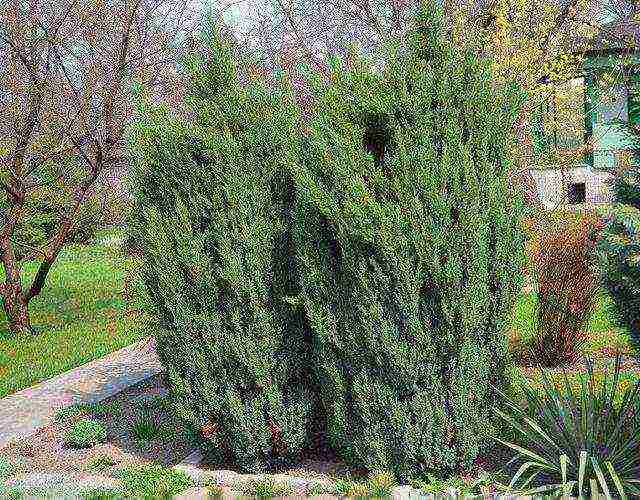
Juniper properties, application
Beneficial features
Common juniper has the following beneficial properties:
- diuretic;
- has a bactericidal effect on pathogenic strains of bacteria in the urinary and digestive tract;
- helps with edema caused by kidney disease and urinary tract inflammation;
- medicinal properties are sometimes used for cardiovascular diseases;
- sweet and spicy spice is used for joint pain;
- for rheumatic diseases and skin acne, a bath with twigs and fruits is recommended;
- the oil is used externally for nerve pain.
Contraindications
However, it is worth knowing that prolonged use of juniper extracts or too high doses can cause irritation of the mucous membrane of the gastrointestinal tract and kidneys, dilation of blood vessels and a prolonged inflammatory reaction. Juniper preparations should not be used by pregnant women.
Collection and use of fruits
Juniper berries are harvested in late autumn and winter for medicinal purposes. They should be ripe, deep purple, almost black. Then they have a pleasant balsamic smell, called forest, the taste is bitter, slightly spicy.
Berries contain:
- tannins;
- flavonoids;
- resin;
- wax;
- carbohydrate compounds;
- mineral salts;
- organic acids.
Application of berries:
- juniper fruit extracts slightly increase the secretion of bile;
- increase the production of gastric juice;
- stimulate intestinal motility;
- increase the secretion of sweat;
- Juniper berries are part of herbal blends that aid in liver detoxification
- they can also be taken orally for digestive problems and flatulence according to a special scheme, increasing their number and then decreasing it.
Cooking applications
Juniper berries, juniper tree and the ends of its shoots contain essential oils used to flavor vodka, syrups, liqueurs, juices, tinctures and gin, where they are an important ingredient. Juniper berries were used to brew beer. Juniper is also a part of many mixtures of different types of seasonings. Its fruits ripen in two years and are already suitable as a seasoning for marinating meat, especially venison and fish. They are also added to kale and sauerkraut and red beets.

